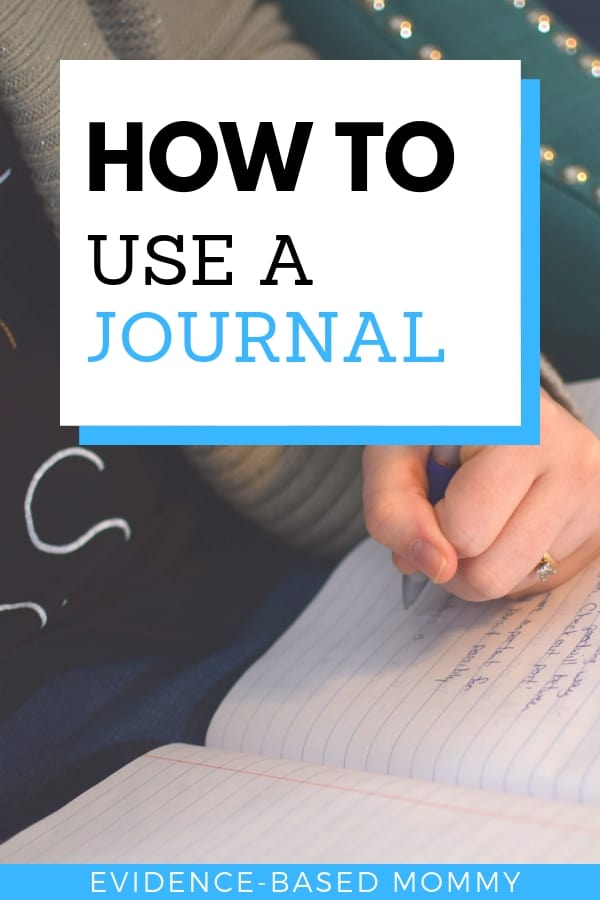Do you as a person sometimes get ignored within that all-consuming title of “mom?” You need a way to reconnect with yourself. Journaling is a great way to do just that!
Moms often forget to look inward, because we’re so busy taking care of the pressing task of the moment—diapers, dinner, piano practice. Our feelings and aspirations matter, so give them some attention!
That’s why I’ve asked Gina from Steps to Self to share how journaling is beneficial for moms!
Disclosure: This article contains affiliate links. As an Amazon associate I earn from qualifying purchases. You can read my full policy here.
This post describes different types of journaling to help you find a good fit for you. It also includes tips for starting a successful journaling habit so you can reap the benefits from this practice.
Table of Contents
Benefits of Journaling
Journaling has so many benefits! Let’s check them out.
Physical benefits of journaling
Believe it or not, journaling has a positive impact on physical health. By reducing stress and anxiety, journaling can lower blood pressure, help with memory and thinking, and boost the immune system.
Journaling for setting and meeting goals
The simple habit of journaling can inspire creativity and help you to define and achieve your goals. More than just making a to-do list, journaling allows you to really think about your desired end point and what tasks you need to do to get there.
And those who journal are in good company! Leaders and visionaries such as Oprah, Nelson Mandela, Benjamin Franklin, and Mark Twain have all kept a journal.
Journaling for enjoyment
Finally, writing in a journal can just be fun! As moms, we often feel a sense of urgency with all the things we “have” to do. Journaling is a nice time to drop your agenda and just do something for the sake of pleasure.
How to pick the best kind of journal for you
There are lots of ways to use a journal. What that means, though, is that not every journal will fit every purpose. So how do you choose what kind to get?
Let’s explore the types of journals you can keep. As you read though, think about what you’re hoping to accomplish and how each one might fit with your personality style and life.
Traditional Journal
The free-form journal is the most classic of journal styles. It’s the diary you kept as a middle schooler—empty pages where you can pour your heart out.
A simple but well-made notebook is best for this kind of journal. Something that doesn’t have structure inside but looks like a book you value.
This style of journaling can be great for getting all your thoughts out before you go to bed. It’s a daily opportunity for a brain dump of your feelings, worries, and desires.
The lack of structure provided can be freeing. Go wild and share whatever is on your mind! It can feel like talking to a dear friend and provide relief to get everything off your chest.
It’s hard to go wrong with the tried and true traditional method of journaling. Anyone can do it.
My grandmother kept a journal religiously. It was a way for her to record her life. She’d write about the weather, visits from family, and whatever thoughts she had. It was one of her favorite activities and she felt kept her mind sharp.
One line a day journal
On the flip side, some can find the blank page of a free-form journal intimidating. What do you write?
Plus, with a traditional journal, there is the potential to get carried away by your free-flowing thoughts in a way that is not as beneficial. For this reason, some choose to set a time limit, such as 5 minutes per day, for journaling.
An even briefer version is the one thought or sentence per day journal. It’s as simple as it sounds. This can be a quick and easy way to get yourself into the journaling habit and practice daily reflection (this beautiful one has dates so you can record your thoughts for five years and then review them and see how you’ve grown!).
Visual journal / sketch journal
If you are artfully inclined, you can also try a visual form of the free-form journal. Channel your creative energy and create pages featuring your drawings and doodles.
Get a sketch book with nicer paper, suited to drawing, for this type of journaling. You’ll release your feelings and thoughts primarily through your illustrations, supplemented by your written words. This could be a lot of fun!
Guided Journal
Guided journals provide prompts to lead you in self-reflection. They can be centered around a specific topic, like personal development, healthful living, or faith.
These journals make it easy to get started by taking what can be the hardest part of writing out of the equation: staring at the blank page and figuring out what to write about.
As a journaling newbie, I chose a guided journal to get started in my practice. You can find find prompts online to use, or you can just buy a journal that has the prompts already included (I love this one!).
A bonus of guided journals is that the provided prompts often make you think about things you would not normally reflect on every day. They get you to examine different areas of yourself and your life, opening your mind to how you see things and how you want them to be.
Guided journals take you on a path of self-exploration. As a busy working mom, I really appreciate the push to get back to thinking about myself.
On my own, it can be hard to turn my thoughts inward when so much of my day is filled with to-do lists and attending to everyone else’s needs. In this way, I found prompts quite useful.
However, guided journals can feel restrictive in that you don’t necessarily get to choose what topic to write about each day. If you’re really seeking a daily method of release, the free-form traditional journal may be the way to go.
Gratitude Journal
When I began journaling, one of the other types I started out with was a gratitude journal. Let me tell you, I got hooked quick.
The idea is simple: jot down things from each day that you’re grateful for. I write down three each day, making them as specific as possible. So rather than “my kids,” it will be something like, “my daughter’s giggle.”

The habit is so good for boosting mood. You’ll be surprised how many little things you start to appreciate throughout the day.
Even on the crappiest of days, you’ll find you have something to write down. It really changes your mindset to be able to see all the little pieces of good in your life.
I like this journal because it prompts you to think about what you’re thankful for. Plus it’s just beautiful!
It’s so easy and yet truly transformative.
My advice: start a gratitude journal. You’ll be so glad you did.
Vision Journal
It’s easy to lose track of your personal goals when focusing so much on day-to-day life. By writing down where you want to go, you’ll be investing in yourself. Enter vision journaling!
A vision journal is designed to help you achieve your goals and dreams. It’s a vision board in journal form. The most common method is to have a page or section for each goal.
You’ll write out your goal, then add images, inspirational quotes, and your plans for reaching your goal.
Next, you’ll use your vision journal to track your progress towards your goals and stay aligned with what you hope to achieve. This type of journal keeps you future-focused and acting more intentionally.
Refer to it daily and add new inspiration, thoughts, or resources. Keep yourself honest by noting how you’re doing against your plan.
You can create your own vision journal from scratch or use downloadable templates or prompts (or if you’re into manifestation, I get a kick out of this tongue-in-cheek journal).
Have fun with it and be amazed by what you can achieve!
Bullet Journal
Have you heard people raving about bullet journals? Users claim they’re life-changing.
So what is a bullet journal, anyway?
They’re productivity journals that use bulleted lists to organize tasks and thoughts. You create page layouts for a view of the year, month, and week. Within these, you use different bullet symbols to categorize each item.
In addition to things you want to accomplish, you jot down quick notes of anything that’s on your mind. They’re like a mashup of a diary, vision journal, and planner.
There are lots of tutorials out there and whole communities sharing bullet journal ideas.
The Moleskine journal with a dotted grid is the standard for bullet journaling because it’s more customizable than the typical lined journals.
They help you accomplish your small tasks, as well as track big-picture goals over time to stay on track. They also get the running to-do list out of your head and onto paper so you can clear your mental clutter (and don’t we all need help with this as moms?).
The special lingo, systems, and images of elaborately decorated pages can seem intimidating. But you don’t have to go over the top making every page Instagram-worthy—even those without beautiful handwriting can benefit from this method of journaling.
The bullet method of writing is designed to be quick. Users report it takes about an hour each month for initial setup, then 10 to 15 minutes every day. (Though you certainly could spend more time with decorative elements if you choose to.)
Bullet journals will appeal to those who enjoy crossing things off to-do lists, those with a passion for organization, and those with a creative side. However, they may not scratch the itch for those who like to use writing as a method of expression.
Tips for Starting a Journal
Which one of these sounds like they might meet your needs? Go with your gut and give one a try. You can start any time of year. And don’t worry, you can always change things up later.
The important part to getting the most out of journaling is to make it a habit. Choose a specific time each day (generally morning or evening) to write in your journal.
Journaling can be part of your self-care practice by taking time for reflection and to attend to your own needs and desires.
Hopefully you will begin to look forward to this quiet time for you each day. Have a cup of tea or sit in your favorite spot. It should be an enjoyable experience and not feel like a chore.

I keep my journal on my nightstand and work on it before bed. It’s a nice way to reflect on my day and release my thoughts before I go to sleep. I’m a night owl and appreciate the opportunity to wind down.
Journaling should be low pressure. Don’t worry about making it perfect—it’s just for you! If you forget to write one day, pick it up again the next. It takes time to develop habits.
So what are you waiting for? Have fun picking out your journal and some pens or supplies that get you inspired. Then get started!
Check in with yourself after a month or two and see how you’re feeling. I’d love to hear how it’s going!
Don’t be afraid to change things up or try a different style of journal if you feel it may better suit your needs. It’s all about benefiting you.
Connect with me on social to ask questions or share your journey with journaling.
Find more from Gina on the Steps to Self blog. As a working mom of four, she’s learned the hard way the importance of self-care. Her passion is helping other moms attend to themselves and live their best life. Professional writer by day, Gina is a Southern girl who loves the beach and has a serious weak spot for gummy bears.
Blog: http://www.stepstoself.com Pinterest: @stepstoself
Instagram: @stepstoself Facebook: Steps to Self
Twitter: @stepstoself








I suffer with anxiety and journaling really helps. I have used bullet journals also and I love colouring it helps to calm and focus my mind on something else. Thank you for sharing xx
You’re so welcome Lauren!
You did such an incredible job in explaining all the different approaches of journaling! I started journaling last year (the traditional way). However, I’m really looking into switching up to bullet journaling and gratitude journaling. Thanks for sharing all the tips!
–
GABBY | http://www.gabbyabigaill.com
This is a great post! I have never seen journaling ever broken down in such a way. I suppose I have always used the traditional and gratitude methods. But I like the idea of using prompts to focus the mind in a particular direction. Thank you for sharing.
Thank You